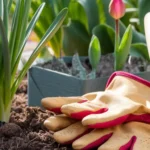How Hard Could It Be?
I thought growing vegetables would be a walk in the park. Just dig a hole, drop in some seeds, water them occasionally, and boom—fresh produce. Easy. Or so I thought.
Sure, I got a couple of peppers, but the rest? A full-blown disaster. Weeds took over like they were trying to start a turf war. Some plants just never sprouted. Others made it halfway, then quit like they were sick of me. It was such a mess I had to rip everything out and start from scratch.
The next year, I actually learned what I was doing. And let me tell you, there’s a lot more to vegetable gardening than just planting stuff and hoping for the best. If you’re not protecting your garden, pests and diseases will find you. It’s not a matter of if—it’s when.
This guide barely scratches the surface of keeping a vegetable garden healthy, but it’s a solid place to start. Let’s get into 14 ways to keep your plants thriving without losing the battle to bugs and fungi.
1. Start with Healthy Soil
If your soil is bad, your plants don’t stand a chance. Weak plants are like a free buffet for pests. You might as well roll out a tiny red carpet and welcome them in.
- Feed the soil with compost to keep nutrients high and plants strong. Think of it like a meal plan for your veggies—junk soil leads to junk growth.
- Rotate crops each year so the same plants aren’t constantly sucking up the same nutrients. Keeps the soil fresh and the plants happier.
- Add mulch to help retain moisture and stop soil-borne diseases from splashing up onto your plants. Bonus: it also makes your garden look like something straight out of a magazine.
Healthy soil means fewer problems down the road. And trust me, you want fewer problems. Ready for the next way to keep your garden alive? Let’s keep going.
2. Pick Plants That Don’t Tap Out Easily
Some plants are built to survive. Others are more like me when I attempt a workout—one minor inconvenience, and they’re done. If you don’t want your garden to turn into a sad, disease-ridden mess, start with plants that can hold their own.
- Look for seeds labeled “disease-resistant.” These guys have been bred to fight off common garden plagues like blight, mildew, and wilt.
- Tomatoes, peppers, and cucumbers are some of the best at fending off plant diseases. A little extra planning now = fewer moments of existential crisis when your plants randomly shrivel up.
I once planted what I thought was a promising batch of tomatoes, only to watch them turn into a sad, moldy disaster. Lesson learned. Disease-resistant varieties are the way to go.
3. Plant Some Bodyguards
Some plants work better in pairs. Not in a romantic way, but in a “Hey, I got you” kind of way. Certain plants naturally help each other thrive, repel bugs, and keep disease in check. It’s basically teamwork, but for plants.
- Marigolds are nematode-repelling MVPs. Plus, they make your garden look like it actually belongs in a magazine.
- Basil protects tomatoes from aphids. Also, fresh basil = instant upgrade for pizza.
- Garlic tells bad bugs to take a hike. Bonus: it also keeps vampires (and maybe your nosy neighbor) out of your garden.
If you’re not sure which plants play nice together, check out a companion planting chart. It’s like picking the right roommates—some combos just work, and others… well, let’s just say you don’t want that kind of chaos in your garden.
4. Keep Pests Guessing
Planting the same thing in the same spot every year is like giving pests a GPS pin to their next meal. Don’t make it easy for them.
- Rotate crops every season to keep pests confused and stop soil nutrients from getting sucked dry.
- Mix up where you plant leafy greens, root veggies, and fruiting plants. Keeps things fresh, keeps pests lost, and makes you look like you actually know what you’re doing.
Think of it like rearranging your furniture. Except instead of a fresh new look, you’re preventing a bug invasion. Both are great, honestly.
5. Keep Pests in the Friend Zone with Row Covers & Netting
Bugs and birds might love your garden, but let’s be real, they’re the kind of guests that show up uninvited, eat everything, and don’t even offer to help clean up. Time to set some boundaries.
- Floating row covers keep sneaky caterpillars and aphids from munching on baby plants before they even get a chance to shine.
- Fine mesh netting blocks birds and bugs from treating your strawberries like an all-you-can-eat buffet.
Think of it like putting your plants in a VIP section. The pests can see the party, but they’re not on the list.
6. Call in the Bug Squad
Not all bugs are out to ruin your gardening dreams. Some are actually little garden superheroes, handling pest problems for you.
- Ladybugs, lacewings, and praying mantises are basically the garden’s version of an unpaid security team. They keep aphids, mites, and other freeloaders in check.
- Flowers like dill, fennel, and alyssum attract these little warriors and convince them to stick around.
It’s like setting up free housing for crime-fighting bugs. Just way cuter and with less paperwork.
7. Take Out the Trash—The Pests Will Thank You (By Leaving)
Pests love a messy garden. Fallen leaves? Free shelter. Rotten fruit? Five-star meal. Weeds? A jungle gym where they can plot their takeover.
- Get rid of dead leaves, rotting plants, and fallen fruit before your garden turns into an insect Airbnb.
- Weed like you mean it because bugs thrive in the mess.
It’s like cleaning out your fridge. You could leave that sketchy container in the back, but you’ll regret it when you open it and it smells like sadness.
8. Stop Watering Like a Newbie
A rookie mistake? Spraying your whole plant like it’s a Slip ‘N Slide. Wet leaves are practically an engraved invitation for mildew and fungus.
- Water at the base of the plant where it actually counts.
- Soaker hoses and drip irrigation are the MVPs here. They keep the roots happy and the leaves dry.
It’s like hydrating after a workout. You wouldn’t just pour water on your head and call it good. Well, unless it’s August and you’re desperate.
9. Spray ‘Em Away (The Natural Way)
If the bugs won’t take the hint, it’s time for a gentle but firm get lost.
- DIY neem oil, garlic spray, and soapy water work wonders without turning your garden into a science experiment.
- Spray in the morning or evening unless you want crispy, sunburnt plants.
Think of it like homemade bug repellent, except this one won’t leave you smelling like a citronella candle for the next 48 hours.
10. Mulch: The Ultimate Garden Security System
Mulch is basically the bodyguard of your garden. It stands between your plants and all the things that want to ruin them—pesky weeds, moisture-sucking sun, and soil-borne diseases waiting to splash up like an unwanted surprise.
- A thick layer of straw, shredded leaves, or wood chips blocks out weeds and keeps soil nice and damp.
- It stops disease-causing bacteria from getting kicked up onto your plants when you water or when it rains.
- It also keeps the soil temperature steady, which means fewer stressed-out plants.
Basically, mulch is like sunscreen for your garden. Except instead of SPF, it’s got SPF-Stop-Weeds-From-Taking-Over.
11. Handpick Pests Like You’re on an Episode of “Survivor”
Some pests are easy to miss. Others, like fat green hornworms, are so massive they should pay rent. Either way, if you spot one, it’s time for an eviction notice.
- Check your plants daily for any creepy crawlers—especially the undersides of leaves where they like to hide.
- Pick them off by hand and toss them into a bucket of soapy water. Trust me, it’s weirdly satisfying.
- If you’ve got a lot of pests, go out at night with a flashlight. Some, like slugs, love to party after dark.
I know, I know. Picking off bugs isn’t the most glamorous gardening job. But if it helps, just imagine you’re a reality show contestant and these bugs are standing between you and a million-dollar prize. That might make it feel more heroic.
12. Give Your Plants a Little Elbow Room
Plants need their personal space, too. When they’re crammed together like rush-hour commuters, airflow is limited, and that’s how fungal diseases sneak in.
- Trim off excess leaves on tomatoes, cucumbers, and squash to keep air moving.
- Space plants properly so their leaves aren’t constantly touching. If you think you planted too close, you probably did.
- Avoid overhead watering—soaking the leaves makes it easier for diseases to spread. Instead, water at the base.
Think of this like an open-concept house. More space = more airflow = fewer problems. Your plants won’t say “thank you,” but they’ll grow stronger and healthier, which is basically the plant version of a high-five.
13. Be Merciless With Sick Plants
Sick plants are like that one friend who always brings drama—cut them off before they bring everyone else down.
- Look out for yellowing leaves, weird spots, or fuzzy white mildew. These are all signs something’s wrong.
- If a plant is too far gone, yank it out immediately. Leaving it in the garden is like letting a cold spread in a crowded room.
- Never compost diseased plants. The bacteria and fungi can stick around and come back to haunt you next season.
It might feel harsh, but trust me, your garden will be better off. Sometimes, tough love is the best kind of love.
14. Keep a Garden Journal (Because Your Memory Will Betray You)
Every spring, I swear I’ll remember which tomato variety rocked and which one flopped. And every year, my brain decides to delete that info like an old voicemail.
- Write down what worked and what didn’t. If your zucchini got wiped out by squash bugs, you’ll know to prepare for battle next season.
- Track which plants thrived next to each other. Some combos work better than others, and you don’t want to relearn that lesson the hard way.
- Note when pests showed up and what methods helped. That way, you can be one step ahead instead of playing defense.
This is basically your garden’s yearbook. Except instead of prom pictures and bad haircuts, it’s filled with notes on soil amendments and pest strategies. And it’ll make your life a lot easier next season.
The Battle for Your Garden Starts Now
Pests and diseases aren’t going to pack their bags and leave on their own. You’ve got to fight back.
- Encourage the good bugs, like ladybugs and lacewings, to help you out.
- Rotate crops so pests don’t get too comfortable.
- Keep things clean so your garden doesn’t turn into an all-you-can-eat buffet for bugs.
Which of these tricks have you tried? Got a go-to method for keeping pests in check? Drop a comment, save this guide for later, and let’s make this the year your garden actually thrives instead of turning into a buggy disaster zone.
FAQ
What can I spray on my vegetable plants to keep bugs off?
If you want to keep bugs off your vegetable plants without turning your garden into a toxic wasteland, homemade and organic sprays are the way to go. Here are some solid options:
- Neem Oil Spray – Mix 1 teaspoon of neem oil, a few drops of dish soap, and a quart of water. Spray it on plants in the evening to suffocate pests without harming beneficial bugs.
- Garlic & Chili Pepper Spray – Blend 2 cloves of garlic, 1 hot pepper, and 2 cups of water. Let it sit overnight, strain, and spray to deter everything from aphids to rabbits.
- Soap & Water Spray – Mix a teaspoon of mild dish soap with a quart of water. It’s great for soft-bodied bugs like aphids and spider mites, but don’t overdo it or you’ll dry out the plants.
- Diatomaceous Earth (DE) – Not a spray, but a light dusting of DE on leaves and soil slices up soft-bodied pests like a microscopic horror movie. Just reapply after rain.
How do I identify my garden pest?
Bugs are sneaky, but their damage leaves behind clues. Here’s how to play detective:
- Chewed-up leaves with holes – Probably caterpillars, beetles, or slugs.
- Sticky residue on plants – Could be aphids or whiteflies leaving behind honeydew (which sounds cute but leads to mold).
- Wilted plants with no obvious reason – Might be root-feeding grubs or nematodes messing up your soil.
- Tiny webbing on leaves – Spider mites. Tiny but destructive.
- Large, round holes in fruits and veggies – Likely hornworms, slugs, or birds.
- Odd-looking trails on leaves – Leaf miners. Their babies tunnel through your plants like freeloaders.
If you’re still unsure, check the undersides of leaves or go out at night with a flashlight. Some pests love to party when the sun goes down.
How do I get rid of pests in my vegetable garden?
The best defense is a multi-step approach. No single trick works on everything, so try a combo of these methods:
- Hand-pick larger pests – Grab hornworms, slugs, and beetles and toss them in soapy water.
- Encourage beneficial insects – Ladybugs, lacewings, and praying mantises are nature’s pest control squad.
- Use row covers – Keep flying pests away from young plants by covering them with breathable fabric.
- Apply organic sprays – Neem oil, garlic spray, and insecticidal soap help without harming pollinators.
- Plant pest-repelling companions – Basil repels flies, marigolds keep nematodes away, and garlic annoys pretty much every pest.
- Rotate crops – Don’t plant the same thing in the same spot every year. Bugs and diseases get too comfortable.
How do I keep critters out of my vegetable garden?
If you’ve got rabbits, deer, or groundhogs treating your garden like an all-you-can-eat buffet, here’s how to make them think twice:
- Fencing is king – A 3-4 foot fence for rabbits, 8-foot for deer, and buried wire mesh to stop burrowing animals.
- Motion-activated sprinklers – Critters don’t love surprise showers.
- Natural repellents – Sprinkle blood meal, garlic powder, or crushed eggshells around plants to make things smell unpleasant.
- Row covers – Lightweight fabric can keep out bugs and small critters.
- Plant deterrents – Rabbits hate onions and deer avoid strong-smelling herbs like rosemary and sage.
If all else fails, consider a garden gnome army. At the very least, it’ll add some intimidation.


























